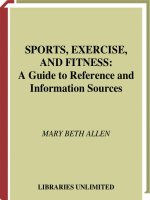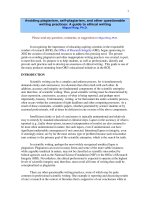Everyday arguments a guide to writing and reading effective arguments katherine j mayberry
Bạn đang xem bản rút gọn của tài liệu. Xem và tải ngay bản đầy đủ của tài liệu tại đây (20.33 MB, 465 trang )
E V E R Y DAY
ARGUMENTS
This page intentionally left blank
E V E R Y DAY
ARGUMENTS
A Guide to Writing and Reading
Effective Arguments
THIRD EDITION
KATHERINE J. MAYBERRY
Rochester Institute of Technology
HOUGHTON MIFFLIN COMPANY
Boston New York
Publisher: Patricia Coryell
Editor-in-Chief: Carrie Brandon
Sponsoring Editor: Lisa Kimball
Marketing Manager: Tom Ziolkowski
Senior Development Editor: Kathy Sands Boehmer
Senior Project Editor: Rosemary Winfield
Art and Design Manager: Jill Haber
Cover Design Manager: Anne Katzeff
Photo Editor: Jennifer Meyer Dare
Composition Buyer: Chuck Dutton
New Title Project Manager: Priscilla Manchester
Associate Editor: Sarah Truax
Marketing Associate: Bettina Chiu
Cover Image: Blue Rhapsody © Diana Ong / Superstock
Credits continue on page 427, which constitutes an extension of the copyright page.
Copyright © 2009 by Houghton Mifflin Company. All rights reserved.
No part of this work may be reproduced or transmitted in any form or by any means,
electronic or mechanical, including photocopying and recording, or by any
information storage or retrieval system without the prior written permission of
Houghton Mifflin Company unless such copying is expressly permitted by federal
copyright law. With the Exception of nonprofit transcription in Braille, Houghton
Mifflin is not authorized to grant permission for further uses of copyrighted
selections reprinted in this text. Permission must be obtained from the selections’
individual copyright owners as identified herein. Address inquiries to College
Permissions, Houghton Mifflin Company, 222 Berkeley Street, Boston,
MA 02116-3764.
Printed in the U.S.A.
Library of Congress Catalog Card Number 2007932698
1 2 3 4 5 6 7 8 9 – EB – 11 10 09 08 07
ISBN 10: 0-618-98675-8
ISBN 13: 978-0-618-98675-0
Brief Contents
CONTENTS vii
PREFACE xix
PART I WRITING ARGUMENTS
1 An Introduction to Argument
1
3
2 Where Writing Begins: Motives and Audience
14
3 The Claim
24
4 An Argument’s Support
43
5 Supporting Your Arguments Honestly and Effectively
68
6 Making Reasonable Arguments: Formal
and Informal Logic
86
7 Arguing Facts
103
8 Arguing Cause
119
9 Arguing Evaluations
144
10 Arguing Recommendations
170
11 Writing and Image
192
12 Introductions and Conclusions
204
13 Revising
216
v
vi
BRIEF CONTENTS
PART II READING ARGUMENTS
233
14 Today’s College Student
235
15 The Internet
265
16 Sports
299
17 Earning Your Living
340
18 Diet
365
19 Reading Popular Culture
389
CREDITS 427
INDEX 431
Contents
PREFACE xix
1
PART I WRITING ARGUMENTS
1
An Introduction to Argument
3
AN EXTENDED DEFINITION
THE CLASSES OF ARGUMENT
ARGUMENT THROUGH IMAGE
THE ARGUMENT PROCESS
3
5
6
7
Forming the Argument
Supporting the Claim
Reviewing the Argument
7
8
9
READING ARGUMENTS
10
Reading as Evaluation
Additional Hints for Reading Critically
CONCLUSION
10
11
11
Summary: An Introduction to Argument 12
Suggestions for Writing (1.1) 12
2 Where Writing Begins: Motives and Audience
MOTIVES FOR WRITING
14
14
The Value of Dissonance
Writing Arguments That Are Meaningful to You
Activities (2.1) 17
vii
15
16
viii
CONTENTS
THE IMPORTANCE OF AUDIENCE
Who Is the Audience?
17
17
Activities (2.2) 19
Why Will the Audience Read the Argument?
20
Activities (2.3) 20
What Should the Audience Be Able to Do After Reading
the Argument?
21
Activities (2.4) 22
Summary: Where Writing Begins 22
Suggestions for Writing (2.5) 22
3 The Claim
HOW CLAIMS WORK
Finding a Claim
Keeping Your Working Claim Flexible
24
24
25
27
Activities (3.1) 28
Positioning the Claim
Claim Stated Up Front
Claim Stated at the End of the Argument
Unstated Claim in an Argument
29
29
30
30
Activities (3.2) 31
CLASSIFYING YOUR CLAIM
Factual Claims
31
31
Activities (3.3) 33
Causal Claims
33
Activities (3.4) 34
Evaluations
35
Activities (3.5) 37
Recommendations
37
Activities (3.6) 38
Combination Claims
39
Activities (3.7) 40
Summary: The Claim 41
Suggestions for Writing (3.8) 42
4 An Argument’s Support
SOME VARIETIES OF SUPPORT
Secondary Claims
Activities (4.1) 45
43
44
44
CONTENTS
Comparisons
Appeals to Authority
Appeals to Audience Needs and Values
ix
45
45
46
Activities (4.2) 46
Addressing the Counterargument
SUPPORTING YOUR ARGUMENT VISUALLY
Charts
46
48
49
Pie Chart 49
Bar/Column Chart 50
Line Graphs 51
When Is a Chart Appropriate? 52
What Is the Best Type of Chart to Use? 53
Using Charts Responsibly 53
Tables
Pictorial Images
54
56
Diagrams 56
Cartoons and Drawings 57
Photographs 58
Activities (4.3) 59
ARRANGING YOUR ARGUMENT’S SUPPORT
59
Activities (4.4) 60
DEFINITIONS
When to Define
Types of Definitions
61
62
63
Activities (4.5) 66
Summary: An Argument’s Support 66
Suggestions for Writing (4.6) 67
5 Supporting Your Arguments Honestly and Effectively 68
PLAGIARISM AND WRITTEN ARGUMENTS
Guidelines for Avoiding Plagiarism
69
70
Quotations 70
Paraphrases 70
Summaries 71
Primary or Secondary Sources? 71
Facts 71
Internet Material 72
Plagiarism Illustrated
Plagiarism 1 72
Plagiarism 2 73
Plagiarism 3 73
72
x
CONTENTS
FINDING REPUTABLE SUPPORT
Traditional Research
Electronic Research
CITATION FORM
73
74
74
76
Summary: Supporting Your Arguments Honestly
and Effectively 77
Suggestions for Writing (5.1) 84
6 Making Reasonable Arguments: Formal
and Informal Logic
FORMAL LOGIC
Induction
Deduction
86
86
87
88
Activities (6.1) 92
THE TOULMIN MODEL: A MODERN
VARIANT OF FORMAL LOGIC
93
Activities (6.2) 95
INFORMAL FALLACIES
Ad Hominem Argument
Ad Populum Argument
Circular Argument
Distraction
Either-Or Argument
Emotive Language
False Analogy
Hasty Generalization
Non Sequitur
Post Hoc, Ergo Propter Hoc
Slippery Slope
Strawperson Argument
95
96
96
96
96
97
97
97
97
98
98
98
98
Activities (6.3) 99
Summary: Making Reasonable Arguments: Formal
and Informal Logic 99
EATING DISORDERS IN MALES
Leslie Knowlton
Suggestions for Writing (6.4) 102
100
CONTENTS
7 Arguing Facts
xi
103
WHAT IS A FACT?
FACTUAL CLAIMS YOU WILL MAKE
SUPPORTING FACTS
FACTUAL GENERALIZATIONS
103
104
105
107
Applying the Principles of Induction
107
Activities (7.1) 110
STATISTICS
110
Activities (7.2) 113
Summary: Arguing Facts 113
TWO SAMPLE FACTUAL ARGUMENTS
“VONNEGUT SPEECH” CIRCULATES ON NET
114
117
Dan Mitchell
Suggestions for Writing (7.4) 118
8 Arguing Cause
DETERMINING CAUSE
Brainstorming for Possible Causes
119
119
120
Activities (8.1) 121
Necessary and Sufficient Causes
Identifying Sufficient Causes
Applying the Toulmin Model
121
122
123
Activities (8.2) 123
DISTINGUISHING AMONG SUFFICIENT CAUSES
Method of Agreement
Method of Difference
Method of Proportional Correlation
124
124
125
125
Activities (8.3) 126
CAUSAL CHAINS
CONTRIBUTING FACTORS
126
127
Activities (8.4) 127
Summary: Determining Cause 128
SUPPORTING CAUSAL CLAIMS
Establishing Factuality
Identifying an Acceptable Motivation
Describing the Process of Validation
128
129
129
129
xii
CONTENTS
Qualifying Your Argument
131
Activities (8.5) 131
Summary: Supporting Causal Claims 132
ARGUING EFFECTS
Determining and Supporting a Probable Effect
132
133
Activities (8.6) 135
TWO SAMPLE CAUSAL ARGUMENTS
I, TOO, AM A GOOD PARENT
136
140
Dorsett Bennett
Suggestions for Writing (8.7) 142
9 Arguing Evaluations
EVALUATIVE SUBJECTS AND TERMS
144
144
Activities (9.1) 145
ESTABLISHING THE DEFINITION OF THE EVALUATIVE TERM 145
Presenting the Definition
146
Activities (9.2) 147
Arguing the Definition
Ranking the Qualities in Your Definition
147
148
Activities (9.3) 149
ARGUING THE EVALUATION
Testing Your Evaluation Through the Syllogism
149
151
Activities (9.4) 151
FURTHER METHODS OF SUPPORTING EVALUATIONS
Identification of Effect
Appeal to Authority
Comparison
151
151
152
152
Activities (9.5) 152
THE VARIETIES OF EVALUATIONS
Ethical Evaluations
152
153
Activities (9.6) 154
Aesthetic Evaluations
154
Activities (9.7) 156
Functional Evaluations
156
Activities (9.8) 157
Interpretations
Activities (9.9) 161
Summary: Arguing Evaluations 162
158
CONTENTS
SAMPLE FUNCTIONAL EVALUATION
xiii
162
Suggestions for Writing (9.10) 169
10 Arguing Recommendations
AUDIENCE NEEDS AND VALUES
When Your Values Differ from Assumed Reader Values
170
171
171
Activities (10.1) 173
RECOMMENDATIONS EMPHASIZING THE PRESENT
Establishing the Current Situation
Evaluating the Current Situation
Applying the Toulmin Model
174
174
174
175
Activities (10.2) 176
RECOMMENDATIONS EMPHASIZING THE FUTURE
Presenting the Recommendation
176
176
Activities (10.3) 179
Arguing the Effects of Your Recommendation
179
Activities (10.4) 180
Judging Effects in Terms of Assumed Needs and Values
Applying the Toulmin Model
180
182
Activities (10.5) 183
RECOMMENDATIONS THAT CONSIDER PRESENT
AND FUTURE
183
Summary: Arguing Recommendations 184
TWO SAMPLE RECOMMENDATIONS
THE SIDE EFFECTS OF AFFIRMATIVE ACTION
185
189
Pamela J. Hsu
Suggestions for Writing (10.6) 190
11 Writing and Image
THE ROLE OF VOICE
The Importance of Ethos
192
193
193
Activities (11.1) 195
THE VIRTUES AND LIMITATIONS OF PLAIN WRITING
FIGURES OF SPEECH
Some Cautions About Figures of Speech
Activities (11.2) 198
195
196
198
xiv
CONTENTS
CONNOTATIVE LANGUAGE AND SLANTING
199
Activities (11.3) 200
THE MUSIC OF LANGUAGE
200
Activities (11.4) 201
Summary: Writing and Image 202
Suggestions for Writing (11.5) 203
12 Introductions and Conclusions
INTRODUCTIONS
Strategies for General Introductions
Introductions in Professional Writing
General Suggestions About Introductions
204
204
205
206
207
Activities (12.1) 208
CONCLUSIONS
Types of Conclusions
SUMMARIES
208
209
211
Activities (12.2) 214
Summary: Introductions and Conclusions 214
Suggestions for Writing (12.3) 215
13 Revising
216
WRITING A FIRST DRAFT, REVISING, AND EDITING
SOME SUGGESTIONS FOR SUCCESSFUL REVISING
216
217
Suggestion 1: Give Yourself Some Breathing Space
Suggestion 2: Avoid the Red Pen
Suggestion 3: Review Your Original Purpose and Audience
Suggestion 4: Review Your Organization
Suggestion 5: Review Your Argument’s Coherence
Suggestion 6: Review Your Style
Suggestion 7: Review Your Argument for Faulty Reasoning
Suggestion 8: Use a Word Processor
217
218
218
218
219
219
220
220
Activities (13.1) 220
Summary: Revising 221
AN EXAMPLE OF REVISION
Activities (13.2) 231
Suggestions for Writing (13.3) 232
221
CONTENTS
PART II READING ARGUMENTS
14 Today’s College Student
INTRODUCTION
RETREAT FROM INTIMACY and COMMENTARY
xv
233
235
235
236
Arthur Levine and Jeanette S. Cureton
Suggestions for Writing (14.1) 242
COLLEGE, MY WAY
243
Kate Zernike
Suggestions for Writing (14.2) 249
SUPER EGOS
249
Peter Francese
Suggestions for Writing (14.3) 251
WHO IS A TEACHER?
251
Celeste M. Condit
Suggestions for Writing (14.4) 255
A LOST MOMENT RECAPTURED
256
Sara Rimer
Suggestions for Writing (14.5) 261
STUDENTS BEHAVING BADLY
261
Richard Flacks
Suggestions for Writing (14.6) 264
15 The Internet
INTRODUCTION
DAEMON SEED and COMMENTARY
265
265
266
David S. Bennahum
Suggestions for Writing (15.1) 278
STOP ME BEFORE I SHOP AGAIN
278
James Gleick
Suggestions for Writing (15.2) 284
THOUGHTS ON FACEBOOK
284
Tracy Mitrano
Suggestions for Writing (15.3) 289
THE REAL DIGITAL DIVIDE
economist.com
Suggestions for Writing (15.4) 291
289
xvi
CONTENTS
INFORMATION LITERACY: THE WEB IS NOT
AN ENCYCLOPEDIA
292
Suggestions for Writing (15.5) 296
DIGITAL DIVIDE
296
Wikipedia
Suggestions for Writing (15.6) 298
16 Sports
INTRODUCTION
LITTLE GIRLS IN PRETTY BOXES and COMMENTARY
299
299
300
Joan Ryan
Suggestions for Writing (16.1) 308
WHERE HAVE ALL THE HEROES GONE?
309
Stephen D. Mosher
Suggestions for Writing (16.2) 313
THE CHOSEN ONE
313
Gary Smith
Suggestions for Writing (16.3) 325
PUBLIC USE OF NATIVE AMERICAN NAMES,
SYMBOLS, AND MASCOTS
326
Richard P. Mills
Suggestions for Writing (16.4) 329
SOMETIMES, A GAME MEANS MUCH MORE
THAN THE SCORE
330
John Feinstein
Suggestions for Writing (16.5) 333
BIZBALL
333
Harvey Araton
Suggestions for Writing (16.6) 339
17 Earning Your Living
INTRODUCTION
WHY I WRITE and COMMENTARY
340
340
341
George Orwell
Suggestions for Writing (17.1) 346
FASTEST GROWING OCCUPATIONS
Daniel E. Hecker, Bureau of Labor Statistics
Suggestions for Writing (17.2) 351
347
CONTENTS
ON DUMPSTER DIVING
xvii
351
Lars Eighner
Suggestions for Writing (17.3) 353
LESSONS FROM 2 GHOSTS
353
Scott M. Fisher
Suggestions for Writing (17.4) 356
REVENGE OF THE RIGHT BRAIN
357
Daniel H. Pink
Suggestions for Writing (17.5) 361
THE STRESS MYTH
361
Richard Reeves
Suggestions for Writing (17.6) 363
18 Diet
INTRODUCTION
THE DIET BIZ and COMMENTARY
365
365
366
Donald Jackson
Suggestions for Writing (18.1) 373
INTUITIVE EATING
374
Evelyn Tribole and Elyse Resch
Suggestions for Writing (18.2) 381
INCLUDE ME OUT: A REFLECTION ON “ICE TEA”
381
Fred Chappell
Suggestions for Writing (18.3) 383
MY STORY: BOB
383
Daniel Slosberg
Suggestions for Writing (18.4) 385
BED CONFESSIONS
385
K.D. Elliott
Suggestions for Writing (18.5) 388
19 Reading Popular Culture
INTRODUCTION
POPULAR CULTURE AND THE FAMILY:
HOW MASS-MEDIATED CULTURE WEAKENS
THE TIES THAT BIND and COMMENTARY
Kenneth A. Myers
Suggestions for Writing (19.1) 402
389
389
390
xviii
CONTENTS
LISTENING TO KHAKIS
402
Malcolm Gladwell
Suggestions for Writing (19.2) 413
THE CONTENTS OF WOMEN’S PURSES:
AN ACCESSORY IN CRISIS
413
Daniel Harris
Suggestions for Writing (19.3) 419
TRUISMS, 1978–87
420
From MOMA Highlights
Suggestions for Writing (19.4) 421
WHY WE CRAVE HORROR MOVIES
422
Stephen King
Suggestions for Writing (19.5) 424
NONSENSE WATCH
Howard Fienberg
Suggestions for Writing (19.6) 426
CREDITS 427
INDEX 431
424
Preface
Everyday Arguments combines a straightforward, commonsense rhetoric with a
comprehensive collection of readings.
The rhetoric section (Part I, Chapters 1–13) is based on the principle that virtually all writing is some form of argument. Updates in Part I include an entirely
new Chapter 5 on research and plagiarism—“Supporting Your Arguments Honestly and Effectively”—as well as a number of updated illustrative arguments.
The readings section (Part II, Chapters 14–19), which contains a wide variety
of largely contemporary texts, illustrates the principles and practices contained in
the rhetoric, as well as the critical link between writing and reading arguments.
Part II contains over 35 examples of written arguments. This anthology is gathered from the kinds of writing that most of us read every day. The arguments are
contemporary and varied, with each one illustrating practices and principles
taught in Part I. From a Web site for men with eating disorders to a prize-winning
article in Sports Illustrated, these writing samples demonstrate the central
premise of the rhetoric—that most of the writing and reading we do in our daily
lives falls under the heading of argument. By helping students become critical
readers of argument, these sample arguments likewise contribute to their becoming effective argument writers.
PART I, WRITING ARGUMENTS
Organization of Part I
Part I of Everyday Arguments is organized around the three major phases of argument writing—focusing, supporting, and reviewing:
• Chapters 1 through 6 discuss how to bring a developing argument into
focus—including finding and focusing a claim, identifying and accommodating the audience, and understanding the relationship between claim and
support.
xix
xx
PREFACE
• Chapters 7 through 10 show students how to support the four different
classes of argument—arguments of fact, cause, evaluation, and recommendation.
• Chapters 11 through 13 present the reviewing activities necessary to refine
and polish an argument—considering image and style, composing openings and closings, and revising and editing the argument draft.
These three writing phases are presented in the order students typically follow
when composing arguments, but there are perfectly acceptable and effective exceptions to the typical. The order presented is meant to guide, not prescribe. Further,
the sequential presentation of these writing phases is not meant to contradict the
received wisdom about the recursive nature of good writing. In the real practice of
writing, changes made in one phase lead to changes in others.
Special Features of Part I
The discussion of dissonance in Chapter 2 is unique to argument texts. The question of what moves people to write arguments is a critical one for students that
can lead them to make a greater personal investment in their own writing.
Chapter 5, “Supporting Your Arguments Honestly and Effectively,” discusses
plagiarism within both traditional and digital environments, offering clear guidelines for avoiding plagiarism and examples of acceptable and unacceptable use of
the texts and ideas of others. The second part of this chapter presents helpful principles for distinguishing between reliable and unreliable research sources.
Formal and informal logic are treated uniquely in this text. They are introduced at the point in the argument process where they are most useful—the development and evaluation of the argument’s support. Too often, argument texts
include the theory of logic and examples of informal fallacies without addressing
how they are useful in the actual writing process. Chapter 6 presents both formal
and informal logic as practical tools for creating reasonable arguments.
The inclusion of an entire chapter on style and image (Chapter 11) enriches
the traditional view of argument, which sometimes seems to suggest that effective
arguments have more to do with formulas and principles than with using language fairly and effectively. Here, a writer’s style—the image that he or she projects through the writing—is a fundamental component of argument, not just a
lucky accident of talent.
Everyday Arguments contains many examples that today’s college students
can relate to, plus examples from diverse academic and career areas. This range of
application helps students see the importance of writing effective arguments in
their college courses and also in their postcollege careers.
Because improvement in writing comes only with practice, the emphasis in
all the activities in Part I is on writing. Each chapter gives students many opportunities to practice what they are learning by writing (and rewriting) full and partial arguments.
PREFACE
xxi
PART II, READING ARGUMENTS
Organization of Part II
The readings in Part II of Everyday Arguments are divided into six topic areas—
“Today’s College Student,” “The Internet,” “Sports,” “Earning Your Living,”
“Diet,” and “Reading Popular Culture.” By design, these are not the typical subjects of traditional argument anthologies, which tend to focus on abstract
issues—such as capital punishment or euthanasia—and the classical canon of
arguments addressing them. These six topics were selected to engage students’
attention and demonstrate the importance of regular critical reading and critical
writing.
Each topic area begins with an introduction, including a discussion of the
importance of critical reading on that topic. The first argument in each section is
accompanied by a detailed commentary that serves as a model for the attentive,
critical reading of argument. Following each reading are a set of discussion questions and suggestions for writing.
Special Features of Part II
The arguments contained in Part II of Everyday Arguments are representative
of the reading we do on a daily basis, so students can see the immediate usefulness of
the writing and reading skills they are learning. The arguments are also drawn
from a wide range of contexts—newspapers, Websites, magazines (from the New
Yorker to Wired), and books. The variety of sources gives students many opportunities to study the effect of context and audience on written argument.
The discussion questions following each argument encourage collaboration
among students and are closely tied to the contents of Part I. The suggestions for
writing following the discussion questions are directed toward students of all
ages, backgrounds, and majors, with an emphasis on the stages of composition.
Part II is in continuing conversation with Part I, repeatedly demonstrating the
connection between principle and practice. Part II of Everyday Arguments maintains the same highly practical, student-friendly, writing-intensive approach to
learning how to compose an argument.
SUPPLEMENTS
Instructor’s Manual An Instructor’s Manual is available online at college.hmco
.com/pic/mayberryEA3e.
Companion Website A companion Website includes information for students including chapter summaries, critical reading tools and writing tasks and writing
assignments and Web resources. It also is available at college.hmco.com/pic/
mayberryEA3e.
xxii
PREFACE
ACKNOWLEDGMENTS
Everyday Arguments remains closely tied to the vision I shared with Robert E.
Golden when we began the first edition of For Argument’s Sake more than 25 years
ago. Joe Opiela, then at Little, Brown, understood this vision and published the
book. I am grateful to Anne Smith and her staff at HarperCollins for supporting
my desire to expand For Argument’s Sake into a combination rhetoric and
reader—what became Everyday Arguments. Since then, dedicated editors from
HarperCollins, Addison Wesley Longman, Longman (where I reencountered Joe
Opiela), and Houghton Mifflin have contributed to the evolution and longevity of
this text.
Readers are critical to each new edition of a book, and I have been fortunate
to have benefited from the keen minds of such colleagues as Steven L. Climer,
Baker College of Allen Park, MI; Anthony Gargano, Long Beach City College;
Daniel Gribbin, University of Central Florida; Janet LaBrie, University of Wisconsin at Waukesha; and Bernard W. Quetchenbach, Florida Southern College.
Finally, I am grateful to Stanley McKenzie, provost at the Rochester Institute
of Technology, for giving me time and occasionally resources to continue my commitment to Everyday Arguments.
E V E R Y DAY
ARGUMENTS
This page intentionally left blank









